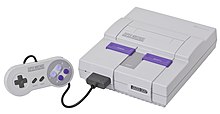
Pac-Man, originally called Puck Man in Japan, is a 1980 maze action video game developed and released by Namco for arcades. In North America, the game was released by Midway Manufacturing as part of its licensing agreement with Namco America. The player controls Pac-Man, who must eat all the dots inside an enclosed maze while avoiding four colored ghosts. Eating large flashing dots called "Power Pellets" causes the ghosts to temporarily turn blue, allowing Pac-Man to eat them for bonus points.
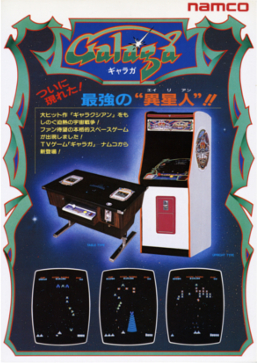
Galaga is a 1981 fixed shooter arcade video game developed and published by Namco. In North America, it was released by Midway Manufacturing. It is the sequel to Galaxian (1979), Namco's first major video game hit in arcades. Controlling a starship, the player is tasked with destroying the Galaga forces in each stage while avoiding enemies and projectiles. Some enemies can capture a player's ship via a tractor beam, which can be rescued to transform the player into a "dual fighter" with additional firepower.

Dig Dug is a maze arcade video game developed by Namco in 1981 and released in 1982, distributed in North America by Atari, Inc. The player controls Dig Dug to defeat all enemies per stage, by either inflating them to bursting or crushing them underneath rocks.
In video game parlance, a multicart is a cartridge that contains more than one game. Typically, the separate games are available individually for purchase or were previously available individually. For this reason, collections, anthologies, and compilations are considered multicarts. The desirability of the multicart to consumers is that it provides better value, greater convenience, and more portability than the separate games would provide. The advantage to developers is that it allows two or more smaller games to be sold together for the price of one larger game, and provides an opportunity to repackage and sell older games one more time, often with little or no changes.

Pac-Land is a 1984 side-scrolling arcade platform game developed and released by Namco. It was distributed in North America by Bally Midway, and in Europe by Atari Games. Controlling Pac-Man, the player must make it to the end of each stage to return a lost fairy back to its home in Fairyland. Pac-Man will need to avoid obstacles, such as falling logs and water-spewing fire hydrants, alongside his enemies, the Ghost Gang. Eating large flashing Power Pellets will cause the ghosts to turn blue, allowing Pac-Man to eat them for points.

Super Pac-Man is a 1982 maze chase arcade game developed and published by Namco. It was distributed in North America by Midway, and is Namco's take on a sequel to the original Pac-Man; Midway had previously released Ms. Pac-Man, which Namco had little involvement with. Toru Iwatani returns as designer.

Pac-Man 2: The New Adventures, known in Japan as Hello! Pac-Man, is a 1994 side-scrolling point-and-click adventure game in the Pac-Man series developed and published by Namco. Instead of being a maze game like the majority of its predecessors, Pac-Man 2 incorporates light point-and-click adventure game elements. The game borrows its structure and certain elements from Pac-Land, and also appears to contain certain elements from the animated series, such as Pac-Man's family and a main villain commanding the ghosts.

Pac-Attack, also known as Pac-Panic, is a 1993 falling-tile puzzle video game developed and published by Namco for the Super Nintendo Entertainment System and Sega Genesis. Versions for the Game Boy, Game Gear and Philips CD-i were also released. The player is tasked with clearing out blocks and ghosts without them stacking to the top of the playfield — blocks can be cleared by matching them in horizontal rows, while ghosts can be cleared by placing down a Pac-Man piece that can eat them. It is the first game in the Pac-Man series to be released exclusively for home platforms.

The Tower of Druaga is a 1984 arcade action role-playing maze game developed and published in Japan by Namco. Controlling the golden-armored knight Gilgamesh, the player is tasked with scaling 60 floors of the titular tower in an effort to rescue the maiden Ki from Druaga, a demon with eight arms and four legs, who plans to use an artifact known as the Blue Crystal Rod to enslave all of mankind. It ran on the Namco Super Pac-Man arcade hardware, modified with a horizontal-scrolling video system used in Mappy.
Namco Museum is a series of video game compilations developed and published by Bandai Namco Entertainment for home video game consoles. The first title in the series, Namco Museum Vol. 1, was released for the PlayStation in 1995. Entries in the series have been released for multiple platforms, including the Game Boy Advance, PlayStation 2, PlayStation Portable, Nintendo DS and Xbox 360. the latest being Namco Museum Archives Vol. 2, released in 2020.

Ms. Pac-Man Maze Madness is a maze chase video game developed and published by Namco for the PlayStation in 2000. It was later released for the Nintendo 64, Dreamcast, and Game Boy Advance. A remake of Ms. Pac-Man (1982), players control the titular character in her quest to stop a witch named Mesmerelda from stealing the Gems of Virtue. The game was well-received upon release, with critics applauding its simplicity and faithfulness to the arcade original. A sequel was in development around 2006, but was cancelled for unknown reasons.

Pac-Man World is a platform video game developed and published by Namco for the PlayStation. Controlling Pac-Man, the player must complete each of the game's six worlds by collecting a certain amount of pellets to open up an exit door. The plot follows Pac-Man's enemies, the ghosts, crashing his 20th birthday and kidnapping his friends and family to bring them to their homeland of Ghost Island — with his birthday in ruins and his family in trouble, Pac-Man sets out to rescue them and defeat the ghosts.
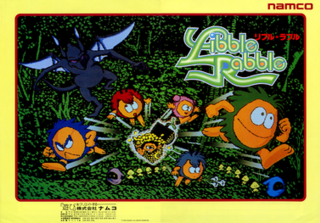
Libble Rabble is a 1983 puzzle arcade video game developed and published in Japan by Namco. The player is tasked with using two colored arrows, Libble and Rabble, to wrap them around pegs and surround small creatures known as Mushlins to "harvest" them under a time limit. The player can also uncover treasure chests that will have the player searching the stage for items in order to access a special bonus stage. It ran on the Namco Libble Rabble hardware, one of the only games to do so.
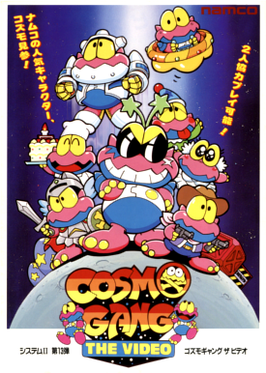
Cosmo Gang the Video is a 1992 fixed shooter arcade game developed and published by Namco. A home conversion for the Super Famicom was released the same year. Controlling the Hyper Beat starship, the player is tasked with ridding the galaxy of the Cosmo Gang, a race of aliens that cause mischief across Earth. Gameplay involves shooting enemies and avoiding projectiles. Power-up items can be collected to grant the player additional abilities. It ran on the Namco System 2 arcade board.
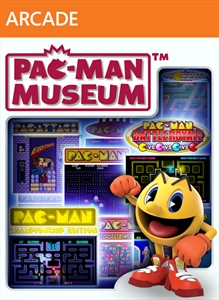
Pac-Man Museum is a 2014 compilation title developed and published by Bandai Namco Entertainment under the Namco label. It is a compilation of 9 Pac-Man games, with additional features such as achievements and online leaderboards.

Cosmo Gang the Puzzle is a 1992 falling block puzzle arcade video game developed and published by Namco worldwide. The third game in its Cosmo Gang series, succeeding that year's Cosmo Gang the Video, players stack groups of blocks and aliens known as Jammers in a vertical-oriented well. The objective is to clear as many objects on the screen before they reach the top of the screen. Blocks are cleared by aligning them into complete horizontal rows, while Jammers are cleared by defeating them with blue-colored spheres.

Namcot Collection, also known as Namco Museum Archives, is a 2020 video game compilation published by Bandai Namco Entertainment. Originally released in Japan for the Nintendo Switch, it was localized for international territories as two separate collections, Namco Museum Archives Vol. 1 and Vol. 2, for the Switch, Xbox One, PlayStation 4, and Windows. Namcot Collection includes a wide array of video games published by Namco for the Family Computer and Nintendo Entertainment System, with save states, achievements, and homebrew ports of Pac-Man Championship Edition and Gaplus.

Mr. Driller A is a 2002 puzzle video game developed and published in Japan by Namco for the Game Boy Advance. The fourth installment in its Mr. Driller series, players control one of seven characters and must make it to the bottom of the level by destroying colorful formations of blocks. A adds several new mechanics to the gameplay of its predecessors, such as a virtual pet named the "Pacteria" that players can grow and care for.

Pac-Man Museum+ is a 2022 compilation video game developed by Now Production and published by Bandai Namco Entertainment. Being a sequel to the 2014 compilation title Pac-Man Museum, Pac-Man Museum+ includes 14 games from the Pac-Man series, with additional features such as missions and online leaderboards.


